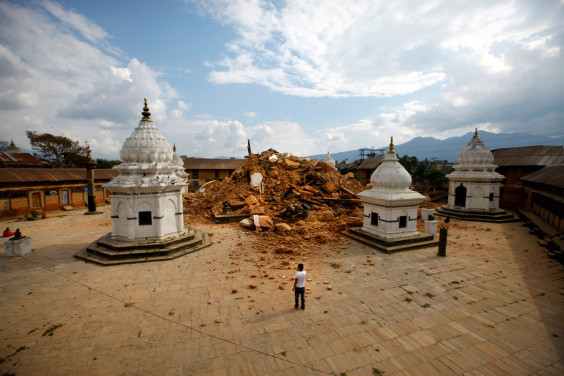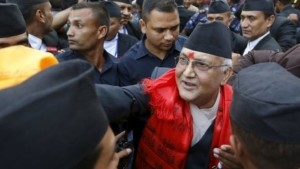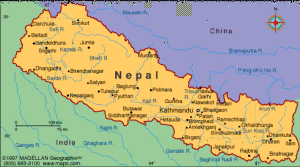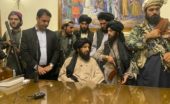Re Ian Bremmer 'Could third-party candidates upend the 2024 US election?' 3 April The current political movement in the USA…
Nepal
Written by Diana Thebaud Nicholson // August 11, 2016 // Asia, Government & Governance // 1 Comment
The Cost of Political Instability in Nepal
(NYT Editorial) Last week, Nepal’s Parliament elected Pushpa Kamal Dahal as prime minister, in the country’s 25th change in leadership in 26 years. Mr. Dahal’s predecessor, K. P. Sharma Oli, resigned last month after only nine months in office.
Political instability is harming Nepal’s struggling economy, which is expected to grow only 1.5 percent this year, and threatens to stall further relief for victims of last year’s devastating earthquake.
Unfortunately, there is little hope for stable governance in the near future. Mr. Dahal, under a power-sharing agreement between his Communist Party of Nepal (Maoist-Center) and the Nepali Congress party, will serve as prime minister for nine months, after which power will pass to Sher Bahadur Deuba, chairman of the Nepali Congress party, for nine months. That transition could well add to the political turmoil involving disputes over Nepal’s new Constitution, which was approved by the Parliament last September, and jockeying between Nepal’s powerful neighbors, India and China.
25 April
Nepal’s Earthquakes: One Year Later
(The Atlantic) On April 25, 2015, a violent 7.8-magnitude earthquake struck Nepal—followed weeks later by a 7.3-magnitude aftershock—killing almost 9,000 people, injuring 22,000, and damaging or destroying nearly 800,000 homes. A year later, some of the debris has been cleared away, but very little reconstruction has taken place. Nepal held memorial services this weekend and Prime Minister Khadga Prasad Oli announced the start of some heritage site reconstruction projects. More than 600,000 Nepalese still live in temporary or unsafe housing.
One year after a powerful earthquake hit Nepal, killing nearly 9,000 people, injuring 22,000 others, and flattening entire villages, hundreds of thousands of people who lost their homes are still living in tents and makeshift homes and very little has been rebuilt. Foreign donors pledged more than $4 billion in aid to Nepal last year, but the country’s government has been slow to use the funds for reconstruction efforts.
21 April
Running on Empty
Visiting Nepal in the midst of its fuel crisis
(Harper’s) It was early February, nearly a year after two major earthquakes struck the country, and we were driving to a Dolakha, a mountain district in eastern Nepal, to survey the reconstruction campaign. Outside the window, the air was thick with the exhaust fumes of idling vehicles.
Fuel was scarce in the country. Five months earlier, Nepal’s ethnic minorities, unhappy with their treatment under a newly adopted constitution, had begun obstructing border crossings between Nepal and India. In response, India had imposed an unofficial blockade on trade with Nepal, claiming that the ongoing protests made it unsafe for its tanker trucks to enter the country.
Nepal conducts 60 percent of its trade with India. The closing of the border created immediate and severe shortages in food, medicine, and gasoline in a country already reeling from last year’s earthquakes. …
Last September, renewed negotiations between Nepal’s political factions, prompted by the urgent need for a coordinated response to the earthquakes, finally led to the adoption of a permanent constitution. It recognized Nepal as a “multi-religious, multi-cultural” secular republic, gave equal rights to women and—a first for an Asian country—provided explicit protections for gay people.
Controversially, the constitution also divided the country into seven new states.
2 March

In this combination of two photos, on left, people look at the debris of one of the oldest temples after it was damaged in earthquake, in Kathmandu, Nepal, Sunday, April 26, 2015, as on right a person looks at the same place after the debris of the temple complex was cleared, in Katmandu, Nepal, Wednesday, March 2, 2016. The violence of the 7.8-magnitude earthquake left countless towns and villages across central Nepal in a shambles. Almost one year later, a shambles they remain. (AP Photo/Niranjan Shrestha)
2015
11 October
 Nepal elects KP Oli as PM amid political crisis
Nepal elects KP Oli as PM amid political crisis
(BBC) The new leader will have to handle continuing protests over a new constitution, the rebuilding of the country after April’s devastating earthquake and a fuel shortage.
Mr Oli, who was backed by a coalition of royalists, Maoists and centrists, is the first prime minister to be elected under the new constitution, defeating the previous prime minister, Sushil Koirala.
Forty-five years ago, Khadga Prasad Sharma Oli was part of a short-lived, violent Communist uprising. That is distant history. Today he is a polarising figure within Nepal, which itself is deeply split on whether the new constitution is democratic enough.
Despite the radical name of his Unified Marxist-Leninist party, Mr Oli’s detractors accuse him of wanting to perpetuate the status quo of high-caste dominance.
They say he has ignored the demands of the southern Madhesi and Tharu ethnic groups, who claim that the new constitution leaves them marginalised and under-represented.
But his supporters see virtue in his bluntness and have greeted his victory as a snub to India, which they accuse of unofficially blockading Nepal to try and force change to the constitution that is backed by Mr Oli.
The Nepali Times quotes him as saying on Saturday that he would “go all out” to address the genuine demands of Madhesis, Tharus and Nepal’s many other excluded groups, as well as to “safeguard our nationality” and rebuild after the earthquakes.
Modern Nepal has always had a rapid turnover of prime ministers and it is difficult to predict how long or short the latest incumbent’s tenure may be.
10 October
A new PM for Nepal – power will trump principles
No matter who wins, one thing can be safely predicted:Nepal will have yet another instable government, the eighth in the past nine years.
(Indian Express) Nepal’s Parliament will elect a new Prime Minister on Sunday but that apparently at the cost of the new constitution.
Incumbent Prime Minister Sushil Koirala decided to go against his earlier commitment to quit the post after the promulgation of the new constitution. Koirala became the Prime Minister in December 2013 with the backing of all major parties on an understanding that he would quit the post after the promulgation of the constitution.
22 September
Why India is upset about Nepal’s new constitution
Ethnic minorities in Nepal are protesting the constitution put into effect on Sunday, but their Indian neighbors to the south are equally worried.
As President Ram Baran Yadav signed Nepal’s new constitution into effect on Sunday, promising his nation that it “has now opened the path for development,” the Indian government immediately issued a curt statement of concern.
The constitution is the fruit of more than seven years of debate and conflict, topped off with April’s devastating earthquakes that killed nearly 8,900 Nepalis – a tragedy that some credit with making the country’s normally f[r]actious politicians more open to compromise. After abolishing the monarchy in 2008, Nepal has struggled to create a government acceptable to its more than 100 ethnic groups.
India is worried about violence spilling across the Nepali border, which is surrounded by India on three sides, and typically quite open. In an interview with The Wall Street Journal last year, Nepal’s ambassador to India, Krishna Prasad Dhakal, stressed the neighboring countries’ extremely close ties: beyond the “tens of thousands” of Nepalis who live or work in India, and vice versa, 65 percent of the nation’s trade is with India, 46 percent of direct investment comes from India, and a quarter of the tourists in its booming travel industry are Indian.
Nepal’s southern border, where most of the constitutional uproar has been concentrated, presents a special difficulty. The Madhesi and Tharu ethnic groups who make their homes there claim that, while the new constitution appears to guarantee representation, its newly created states are actually designed to break minority groups into even less-powerful blocs.
Their discontent has led to rumors of secession, but more likely is migration from southern Nepal into northern India.
Will Nepal’s new constitution hold the country together?
(CSM) Drafted over seven years Nepal’s new constitution divides the nation into seven states, each with its own legislature. But ethnic tensions remain.
The new constitution replaces an interim one that was supposed to be in effect for only a couple of years but has governed the nation since 2007.
The key part of the constitution, passed on Wednesday after a decade of bickering and violent protests, sets the country up as a secular federation of seven states, each with a legislature and chief minister.
However, some ethnic and religious groups say lawmakers ignored their concerns over how state borders should be defined. They want more states, including ethnically based ones, bigger territory for larger groups and more seats for ethnic minorities in parliament and government.
Laxman Lal Karna, a senior leader of the Madhesi ethnic group in southern Nepal, said the new constitution failed to address many of the issues and that protests would continue.
The violence over the past several weeks has left at least 45 people dead. Police said clashes between officers and protesters on Sunday left one demonstrator dead near Birgunj town in southern Nepal.
(See Comment of September 20 below)
20 September
Nepal formally adopts new constitution amid protests from minorities
Security stepped up as smaller political parties and ethnic groups opposed to charter issue fresh threats of violence
2-3 September
Nepal Hasn’t Spent Any Of The $4 Billion In Donations Since Earthquake
But it’s not all gloom and doom.
(HuffPost) It’s been four months since Nepal’s deadliest earthquake hit. Yet, the country still has yet to dole out a cent of the $4.1 billion in donations it received, Reuters reported.
The two back-to-back spring earthquakes claimed more than 8,500 lives and displaced over 2.8 million people. While getting aid into the hands of survivors is critical to ward off malnutrition, diarrheal diseases and prevent instances of trafficking, among other devastating issues, the country has been “slow” to dole out the funds, Reuters noted.
According to the news outlet, the government won’t start spending the relief funds until October. The delay is due to reluctance to start building work during monsoon season and the fact that plans still require approval.
While the U.N. has no qualms with the delays, locals who are struggling to survive and international donors haven’t been so quick to forgive the slow-moving government.
Reuters: Four months after quakes, Nepal fails to spend any of $4.1 bln donor money
2 May
 GlobalMedic, Monadrone and Aeryon Labs collaborate to deliver disaster relief in Nepal
GlobalMedic, Monadrone and Aeryon Labs collaborate to deliver disaster relief in Nepal
In response to the recent 7.8-magnitude earthquake in Nepal, Aeryon Labs Inc., the premier manufacturer of small Unmanned Aerial Systems (sUAS), has deployed three of its sUAS and a qualified Aeryon pilot to the affected region. Aeryon is collaborating with partners GlobalMedic and Monadrone to provide aerial support to international disaster relief teams on the ground. (The National CBC) Disaster Relief Drones — How a Canadian company’s drone technology is helping in Nepal. (video)
2 May
Nepal quake: ‘No chance’ to find more survivors, as death toll rises
Nepal’s authorities have ruled out finding more survivors of last week’s earthquake under the rubble, as the death toll rises to 6,621.
“We are trying our best in rescue and relief work but now I don’t think that there is any possibility of survivors,” Home Ministry spokesman Laxmi Prasad Dhakal told AFP.
Nepal said 14,021 people were injured in the 7.9 magnitude quake on Saturday. The fate of thousands of people in remote areas remains unknown.
30 April
Nepal earthquake: a disaster that shows quakes don’t kill people, buildings do
The kind of earthquake that hit Nepal last week is a periodic event in the country: the last was in 1934. For years, the international community knew another big quake was due in Kathmandu. The disaster is that we have not prepared sufficiently for a predictable event. In a world of increased urban densification, rapidly expanding informal settlements and development that outstrips a government’s ability to enforce standards, it is poorly designed and constructed buildings, not earthquakes, which are the real catastrophe.
29 April
Nepal earthquake: The challenges of disaster relief
Logistics, averting the bottlenecks, co-ordinating the efforts of governments and aid organisations big and small – they quickly become the preoccupations of those overseeing disaster relief operations, like the one following the Nepal earthquake now.
At least four out of seven Unesco World Heritage sites in the Kathmandu valley – three of them ancient city squares – were severely damaged. Nepali Times editor Kunda Dixit told the BBC that the destruction was “culturally speaking an incalculable loss.”
2008
April 17
The Maoists triumph
(The Economist) The former rebels surprise everyone with a stunning electoral success. That may prove to have been the easy part
Managing a fractious coalition is just the start of the Maoists’ troubles. The drafting of the new constitution will be a dreadful business.
And then there is a peace process to salvage. The new government will inherit a huge backlog of peacemaking provisions neglected by its predecessor—including the matter of what to do with the Maoists’ 23,000-strong army, which stands armed and organised, under UN surveillance, and the 90,000-strong royalist army.
“Prachandaism” [which] describes the Maoists’ struggle as a “bourgeois peasant revolution”, is tricky to pin down. Their economic policies, which include seeking foreign investment for Nepal’s hydropower industry, seem quite liberal. Many of their social policies, which the Maoists describe as a war against “feudalism”, are also laudable. Besides scrapping a discredited monarchy, they would fight caste-based discrimination, the deprivation of tribal groups and the exploitation of landless labourers. For poor Nepalis, all this makes a popular message.
NEPAL: Maoists Armed With Popular Vote
By Damakant Jayshi
KATHMANDU, Apr 14 (IPS) – Proving the political pundits wrong, the people of Nepal have voted overwhelmingly for former rebels, the Communist Party of Nepal- Maoist (CPN-M), in the just concluded constituent assembly elections in this Himalayan nation.
Postponed twice the historic election finally took place on Apr. 10.
The new assembly is expected to draw up a new constitution for a republic that will replace rule by a 240-year-old monarchy.
If the CPN-M does gain a simple majority in the assembly, it can be expected to make towards abolishing the unpopular monarchy as its first order of business.
Although the CPN-M has always claimed an undercurrent support among the Nepali public, the results caught them by surprise as much as its rivals.
Except in the central tarai (plains) where regional Madhesi (plainsmen) parties have done well, and eastern hills, the former underground party has swept the elections across the country in which 60 percent of the 17.6 million eligible voters cast their votes. Of these, 4.1 million are newly-registered voters.
April 13
Does the Dalai Lama Know He’s Nepalese?
President Bush’s National Security Adviser Stephen Hadley appeared on ABC’s “This Week” with George Stephanopoulos and repeatedly confused Nepal and Tibet.
Discussing how Bush has “no reason not to go” to this summer’s Olympic games in Beijing and how boycotting them would be wrong, Hadley discussed the outcry over Tibet and the US response, only he kept saying Nepal. More




One Comment on "Nepal"
Till my mid-life (34 years), I have seen 3 Constitutions of Nepal (including 1 Interim Constitution) in making. Today I received many messages congratulating us (Nepali) for the brand new constitution. But unfortunately I am not so happy about this particular constitution. There are many reservations but particularly I am not happy that this constitution has become a seed to increase distrust among Nepali people (some of my friends & family are celebrating this day as historic day whereas some of my close friends refer it as a ‘Black Day’); secondly the serious discrimination against women (I am utterly surprised as one after another being a woman in Nepal does not have any privileges which is a big insult to our wives, sisters and our daughters). There are 3 such instances where … women in my country do not have any rights:
1. A mother has no power to provide citizenship to her own child if her husband is a foreigner which is not the case with Nepali husband and foreign-born wife as their children can easily get the Nepali Citizenship. This also means that many children born out of single parent (children born out of rape or any woman who decides to give birth to a child using donated sperm) will remain stateless.
2. Women do not have any privileges to provide naturalized citizenship to a foreign husband. Article 12 (1) includes another example of discrimination as “foreign women who marry Nepali men will be automatically granted citizenship” but the same does not apply to foreign men who marry Nepali women (such husbands have to wait for 15 years to get citizenship). Which means, their children will possibly remain stateless because of “and” clause as described above.
3. Article 43 (6) recognizes that “couples have equal rights to family property” but the draft is silent on single women’s access to parental property.
I hope this constitution will be the ultimate constitution, which will be acceptable for all of us, and we make necessary changes immediately to correct such blunders and above all address the needs and demands of those people who consider this day as a “Black Day”. I am not so convinced to accept it as “Historic Constitution” and I am not so excited about it so much as I am still mourning the deaths of those 40 men, women and children in these last 2 weeks and I do not rule out the possibility of 4th constitution in making in my lifetime!!! – Manish Thapa